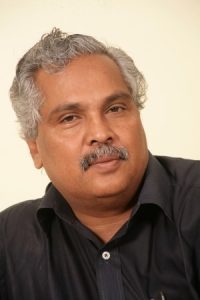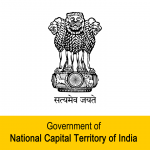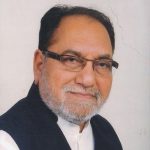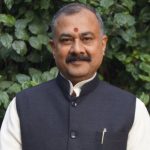Participating Policymakers
 Mr. Asaduddin Owaisi is the President of the All India Majlis-e-Ittehadul Muslimeen and a three-time Member of Parliament (MP) representing the Hyderabad constituency in Lok Sabha. Previously, he was twice elected to the Andhra Pradesh Legislative Assembly during the 1994 and 1999 elections from the Charminar constituency.
Mr. Asaduddin Owaisi is the President of the All India Majlis-e-Ittehadul Muslimeen and a three-time Member of Parliament (MP) representing the Hyderabad constituency in Lok Sabha. Previously, he was twice elected to the Andhra Pradesh Legislative Assembly during the 1994 and 1999 elections from the Charminar constituency.
Mr. Owaisi did his BA from Nizam College. He is a barrister by profession and studied at Lincoln’s Inn of London. Besides being a Member of Parliament, he is also the chairman of Dar-us-Salam Board and is the founder member of the All India Muslim Personal Law Board, New Delhi. He is also the Chairman of Hyderabad-based Owaisi Hospital and Research Centre. The hospital functions in the field of Medical Education, Research and Medical care.
In Parliament, Mr. Owaisi sits on the Standing Committee for Social Justice and Empowerment. He is a vocal advocate for the rights of minorities.
 Mr. Viswam is a Member of Parliament (Rajya Sabha) from Kerala. He is a senior Communist Party of India (CPI) leader who has been with the party since he turned 18, and is currently the president of the Kerala Tourism Development Corporation Employees' Federation. He also serves the CPI in his capacity as its Central Secretariat Member.
Mr. Viswam is a Member of Parliament (Rajya Sabha) from Kerala. He is a senior Communist Party of India (CPI) leader who has been with the party since he turned 18, and is currently the president of the Kerala Tourism Development Corporation Employees' Federation. He also serves the CPI in his capacity as its Central Secretariat Member.
Prior to his nomination to the Parliament, he has been a Forest Minister in the Government of Kerala and was elected multiple times to the Kerala Legislative Assembly from Nadapuram constituency, Kozhikode. During his time as an MLA, he has served as Member (Estimates Committee), as Chairman (Assurance Committee) and was one of the five members of the Constituency Delimitation Committee.
A well-known youth leader in his younger days, he has served as Vice President of World Federation of Democratic Youth (WFDY), and also as the Head of its Asia Pacific Commission. A lawyer by profession, he has also worked with the Nottingham University, UK as a creative writer.
 The Government of the National Capital Territory (NCT) of Delhi is the governing authority of the national capital territory and its 11 districts. Fellows at the Policy in Action Program will be supporting the work of the Urban Development department within the government. This department is currently handled by Mr. Satyendra Kumar Jain who is a Cabinet Minister in the Delhi Government and a Member of the Aam Aadmi Party (AAP).
The Government of the National Capital Territory (NCT) of Delhi is the governing authority of the national capital territory and its 11 districts. Fellows at the Policy in Action Program will be supporting the work of the Urban Development department within the government. This department is currently handled by Mr. Satyendra Kumar Jain who is a Cabinet Minister in the Delhi Government and a Member of the Aam Aadmi Party (AAP).
The department of Urban Development plans for various infrastructure facilities and essential services, such as water supply, sewage disposal, sanitation and is responsible for urban poverty alleviation, and providing funds to as well as coordinating among urban local bodies. Issues of slum development and housing also fall within its purview.
 Mr. Husain Dalwai is a two time Rajya Sabha MP. He was first elected to the Upper House in 2011. He is a member of the Indian National Congress (INC).
Mr. Husain Dalwai is a two time Rajya Sabha MP. He was first elected to the Upper House in 2011. He is a member of the Indian National Congress (INC).
He is a seasoned politician and has previously been a Member of the Legislative Council in Maharashtra and later a Minister for Labour in the Maharashtra state government. He is a diligent Parliamentarian with a high attendance record and actively participates in all debates and discussions on Bills. He has been a member of various Parliamentary Standing Committees including those on Urban Development, Government Assurances and Welfare of OBCs.
Mr. Dalwai is a strong champion for the rights of minorities, dalits, adivasis and farmers. He holds a Masters in Sociology from the University of Mumbai. He is a trade unionist, journalist and writer by profession.
 Mr. Rahul Shewale is a Shiv Sena MP who represents the Mumbai South Central constituency in the Lok Sabha. He is currently a member of the Committee on Public Accounts in the Parliament.
Mr. Rahul Shewale is a Shiv Sena MP who represents the Mumbai South Central constituency in the Lok Sabha. He is currently a member of the Committee on Public Accounts in the Parliament.
In the previous Lok Sabha, he was a member of the Standing Committee on Urban Development, member of the Consultative Committee, Ministry of Chemicals and Fertilisers as well as member of the Railway Convention Committee.
He has served several terms as a corporator in the BMC (Municipal Corporation of Mumbai) where he worked closely on issues affecting the city, including infrastructure, urban poverty and grievance redressal. He is a four-time chairman of the influential standing committee of the BMC. He studied civil engineering from the Government Polytechnic, Bandra.
 Prof. M V Rajeev Gowda was elected to Rajya Sabha in July 2014 from the state of Karnataka. He is a national spokesperson for the Indian National Congress. He was Professor of Economics and Social Sciences and the Chairperson of the Centre for Public Policy at the Indian Institute of Management (IIM), Bengaluru and taught a range of courses. He has served as a Director of the Central Board, Reserve Bank of India.
Prof. M V Rajeev Gowda was elected to Rajya Sabha in July 2014 from the state of Karnataka. He is a national spokesperson for the Indian National Congress. He was Professor of Economics and Social Sciences and the Chairperson of the Centre for Public Policy at the Indian Institute of Management (IIM), Bengaluru and taught a range of courses. He has served as a Director of the Central Board, Reserve Bank of India.
Prof. Gowda studied economics and political science at St. Joseph's College where he was elected as the Vice-President of the Student Union in 1982–83. He was awarded the Bangalore University gold medal in political science and secured a fully funded scholarship to pursue Masters in Economics at Fordham University, New York. Prof. Gowda holds a PhD in Public Policy & Management from Wharton School, University of Pennsylvania. He was also a Post-Doctoral Fellow in Law & Economics from University of Berkeley, California.
Prof. Gowda leads ‘Bengaluru Needs You’ (BNY), a citizen movement to involve and empower people to engage with civic authorities to bring positive transformation in the city of Bengaluru.
 Mr. Sushil Kumar Singh is the incumbent and four-time Member of Parliament from Bihar, and currently represents the Aurangabad constituency. He has also been a member of the state's Legislative Assembly in the past.
Mr. Sushil Kumar Singh is the incumbent and four-time Member of Parliament from Bihar, and currently represents the Aurangabad constituency. He has also been a member of the state's Legislative Assembly in the past.
As a member of the current Lok Sabha, Mr. Singh sits on the Committee on Public Undertakings. Previously, he has been a member of different Standing Committees including energy, information technology, transport and tourism, as well as coal and steel. He has also served as a member of multiple consultative committees formulated by the government in the past.
His interest areas lie in solving the prevailing water and power issues in Bihar and developing backward districts affected by left wing extremism. He was educated at Magadh University in Bihar and holds an MA in political science.
Live Projects
a) Identify and analyze major policies and schemes driving Water, Sanitation and Hygiene (WASH) interventions in urban India, and their impact on public health. Project 2: Ecological preservation and disaster management in the Western Ghats a) Review expert committee reports and judgments in relation to ecological preservation of the Western Ghats, and analyze recommendations made under the same. Examine if, and how, ecological exploitation may be increasing the frequency of natural disasters in the region. Project 3: Housing for the poor in Delhi a) Study the situation of the housing stock in Delhi, especially with respect to quality of construction, affordability and ownership among different income classes. Project 4: State of Mumbai’s public infrastructure a) Examine the state of Mumbai’s public infrastructure with respect to global benchmarks and analyze major instances of public infrastructure collapse/ disintegration in Mumbai over the last decade. Study their impact on citizens’ lives, particularly w.r.t. ensuring safe mobility, and the city’s overall socio-economic development. Project 5: State of labour-intensive industries in the last five years and their impact on employment a) Track the evolution of major labour-intensive industries such as construction, textiles etc. within the manufacturing space in India, and Maharashtra specifically, over the past five years, and analyze their employment trends. Project 6: Slum redevelopment in Maharashtra a) Undertake an analysis of all major slum redevelopment schemes, laws and programs introduced by the government of Maharashtra since the 1970s. Critically examine the efficacy of the same in ensuring access to adequate housing and basic amenities for slum dwellers. Project 7: Analysis of India’s TB control policy a) Map the evolution of India’s TB control program. Analyze various phases of its implementation, and examine its efficacy from the perspective of budgetary allocation, human resource availability, technical assistance, monitoring and supervision. List shortcomings, if any. Project 8: Rent controlled housing in Mumbai a) Map the trajectory of rent control laws – both central and state – in Maharashtra, with specific focus on Mumbai. Analyze the same basis major court judgements and recent amendments considered, in particular the dual rent control model that the state of Maharashtra intends to adopt. Project 9: Addressing revenue shortfalls in the Indian Budget a) Undertake an analysis of India’s union budget over the last 10-15 years to understand major sources of estimated/ projected revenue. Compare with subsequent year’s revised estimates to identify shortfalls with respect to the same, if any. Are there any discernible patterns or trends? How has the situation evolved with the implementation of the GST? Project 10: Impact of GST on key sectors in the Indian economy a) Undertake an analysis of the impact of GST on key sectors such as textiles and precious stones. Study its effects by looking at different indicators, including but not limited to the overall growth of the sector, aggregate profits, consumer sentiment, and employment. Also look at tax revenue from the sectors in question as well as the increase in formalization, if any. Project 11: Interlinking of rivers in Southern Bihar a) Study expert committee reports and feasibility studies on river interlinking in India to analyze whether it will help in improving water availability for drinking water and irrigation. Project 12: Restoration of small water bodies in Bihar a) Analyze the current state of small water bodies (ponds, lakes, tanks etc) in India, with a specific focus on Bihar. Review information related to their use, disuse, and damage. Highlight shortfalls in data collection, if any.
The Mumbai cohort was tasked to work on issues identified by the participating policymakers. Below you’ll find a list of the specific projects the fellows worked on.
Project 1: Strengthening governance structures to improve access to WASH facilities in urban areas
b) Examine the efficacy of such interventions on the target demographic, basis metrics such as – but not limited to – availability of facilities, their usage and maintenance, and associated health indicators, with specific focus on girls/ women and the urban poor.
c) In light of India’s federal structure, explore key enabling and disabling factors that drive the delivery of such services in urban areas. Consider factors such as budgetary allocations and planning exercises, as well as issues arising from migration and urban sprawl.
d) Suggest actionable recommendations basis the aforementioned analysis and international best practices, on ways to strengthen urban governance structures with respect to the above.
b) Map the different stakeholders involved, including the levels of government, and examine the processes followed for seeking sanctions for projects in ecologically sensitive areas in the Western Ghats.* Study the effectiveness of these processes and highlight shortfalls, if any.
c) Examine existing mechanisms for disaster management in the region and analyze the efficacy of the same.*
d) Basis the above analysis and in light of best practices arising out of domestic and international examples, make suitable policy recommendations to reduce the frequency of and to mitigate the impact of natural disasters in the Western Ghats.
b) Examine the different housing policies implemented in Delhi over the past 15-20 years, by both the centre and the state, and their impact on the housing situation in the city, especially with respect to affordable housing for the economically weaker sections (EWS). Highlight shortfalls in delivery and challenges in implementation/ uptake, if any.
c) Through international examples, case studies, and stakeholder consultations, analyze frameworks for improving the creation and uptake of EWS housing stock in Delhi.
d) Basis the above, propose suitable policy solutions.
b) Map relevant stakeholders (including the levels of government) involved in funding, construction and maintenance of such projects and the efficacy of their functioning. Also examine the processes involved in auditing and ensuring quality control of such infrastructure, and their effectiveness.
c) Study international best practices in public infrastructure creation and management at the city level, and draw learnings for the city of Mumbai.
d) Basis above, suggest suitable policy recommendations for Mumbai to bridge existing gaps in policy design and implementation.
b) Identify 2-3 key industries exhibiting signs of slowdown with respect to employment, and analyze the impact of current and proposed government interventions (such as budget allocations, subsidies etc.) on reviving employment in these industries.
c) Examine international best practices to understand the ways in which governments across the world have attempted to boost employment generation in similar contexts. Assess the viability of implementing some of these initiatives in India.
d) Based on your analysis, make suitable policy recommendations to the government.
b) Study at depth, the recent amendments to the Maharashtra Slum Areas (Improvement, Clearance and Redevelopment) Act, 1971 made in the context of the ‘Housing for All’ initiative of the central government, and evaluate the pros and cons of the various rehabilitation models proposed under it.
c) Undertake a review of models of slum redevelopment adopted by other states and/or countries. Study and comment on the efficacy of these alternatives in the context of Maharashtra.
d) Basis the above, suggest recommendations for improving the design and implementation of slum redevelopment interventions in Maharashtra.
b) Through secondary research and stakeholder consultations, conduct an in depth study of the design and implementation of the Revised National Tuberculosis Control Programme (RTNCP) and the National Strategic Plan for TB Elimination. Examine if the changes undertaken can bridge deficiencies in earlier TB programs, and help India meet her commitments under the Sustainable Development Goals (SDGs) 2030 and the 2035 global End TB program.
c) Examine the design and implementation of similar global interventions/ programs which proved successful in eradicating TB, and draw learnings for India.
d) Suggest actionable policy recommendations basis the above.
b) Using stakeholder consultations and secondary research, analyze the design and implementation of these laws in Mumbai, and their impact on the target demographic, and the city’s economy as a whole.
c) Compare rent control regulations across other global metropolises and draw learnings for the city of Mumbai.
d) Based on your analysis, make suitable policy recommendations for the government. In doing so, consider political and economic viability, as well as financial constraints, if any.
b) Investigate major drivers of revenue shortfall for the aforementioned period. Basis secondary research and stakeholder conversations with academia and other experts, examine if the shortfalls are a result of overestimation or genuine incapacity to achieve targets.
c) For each of the above years, identify the different ways through which the government plugged the shortfall, and examine the impact of such policy interventions on economic growth, investments and job creation in the country.
d) Basis the above, make suitable policy recommendations for the government to better estimate and manage its revenue sources. Can parliamentary procedures be strengthened to offer better checks and balances? How do other democracies deal with budget estimates?
b) Using stakeholder consultations and secondary research, examine issues faced by the industry from the point of view of implementation of GST. Study the series of policy changes instituted by the government since GST was first launched and the effect that each of those changes has had on the industry.
c) Undertake a comparative analysis to understand how GST like taxes are levied in other countries, and draw learnings for India. Are the challenges unique to India or specific to the identified sectors?
d) Basis the above, suggest ways by which GST implementation can be improved to provide a boost to the sectors in question.
b) Analyze the current state of policy proposals regarding river interlinking, with a focus on Bihar. Review the extent to which these proposals were implemented and the major challenges that were faced in the process, including environmental concerns and financial constraints.
c) Compare river interlinking policies in India with other parts of the world, and analyze the efficacy of these programs.
d) Based on secondary research as well as extensive stakeholder interviews, comment on the feasibility of furthering river linkages in Southern Bihar, and highlight potential costs and benefits associated with such a move. What policy interventions can the government pursue?
e) Finally, what alternatives should the government explore to improve the availability of water for drinking and irrigation if river linking does not materialize?
b) Analyze the main policies that address repair, renovation and restoration (RRR) of small water bodies, and assess their efficacy in meeting the stated objectives. Using secondary research and stakeholder discussions, identify challenges with respect to policy design or implementation including funding constraints, if any. Are these different across rural and urban areas?
c) Compare efforts in water body repair, renovation and restoration across other states in India and internationally, and draw learnings for Bihar.
d) Basis the above, make suitable policy recommendations for Bihar.
Class profile
Educational background
Age profile